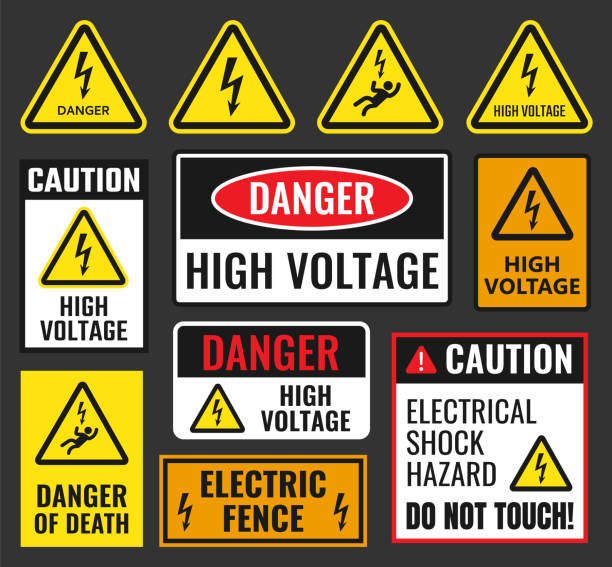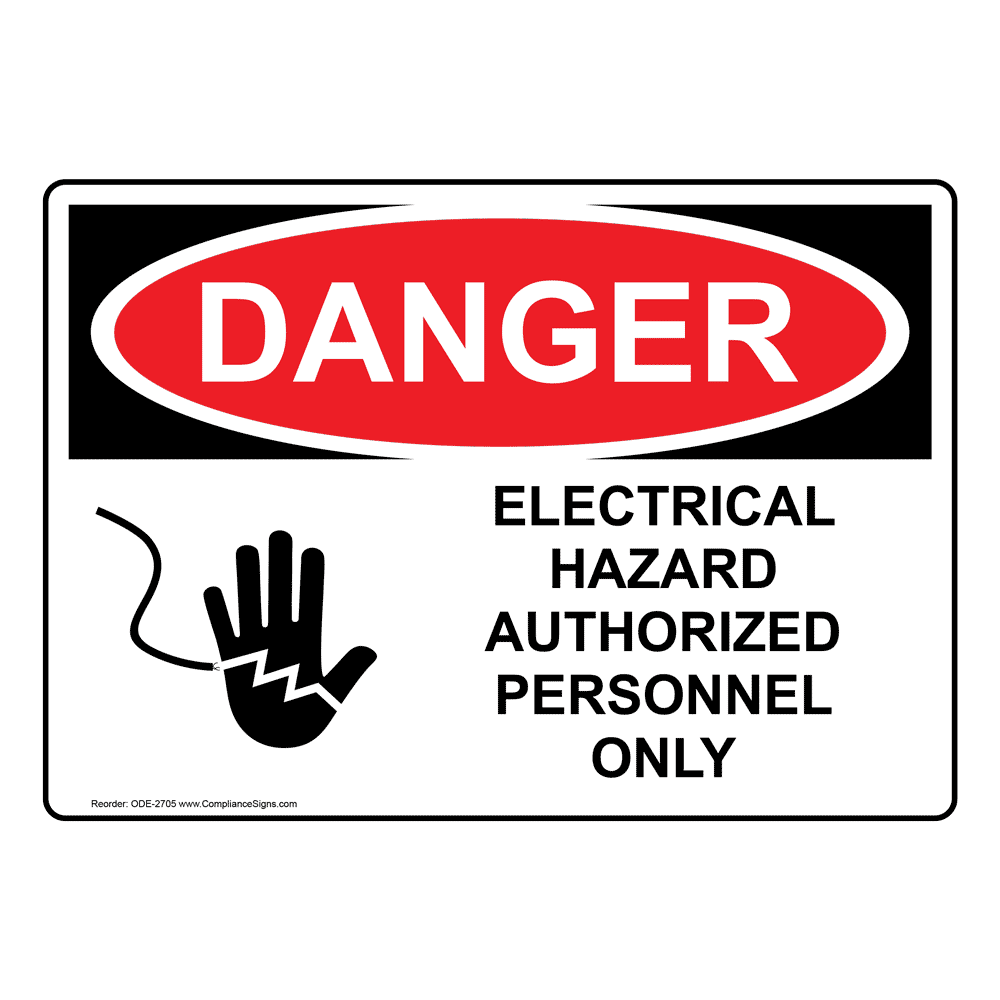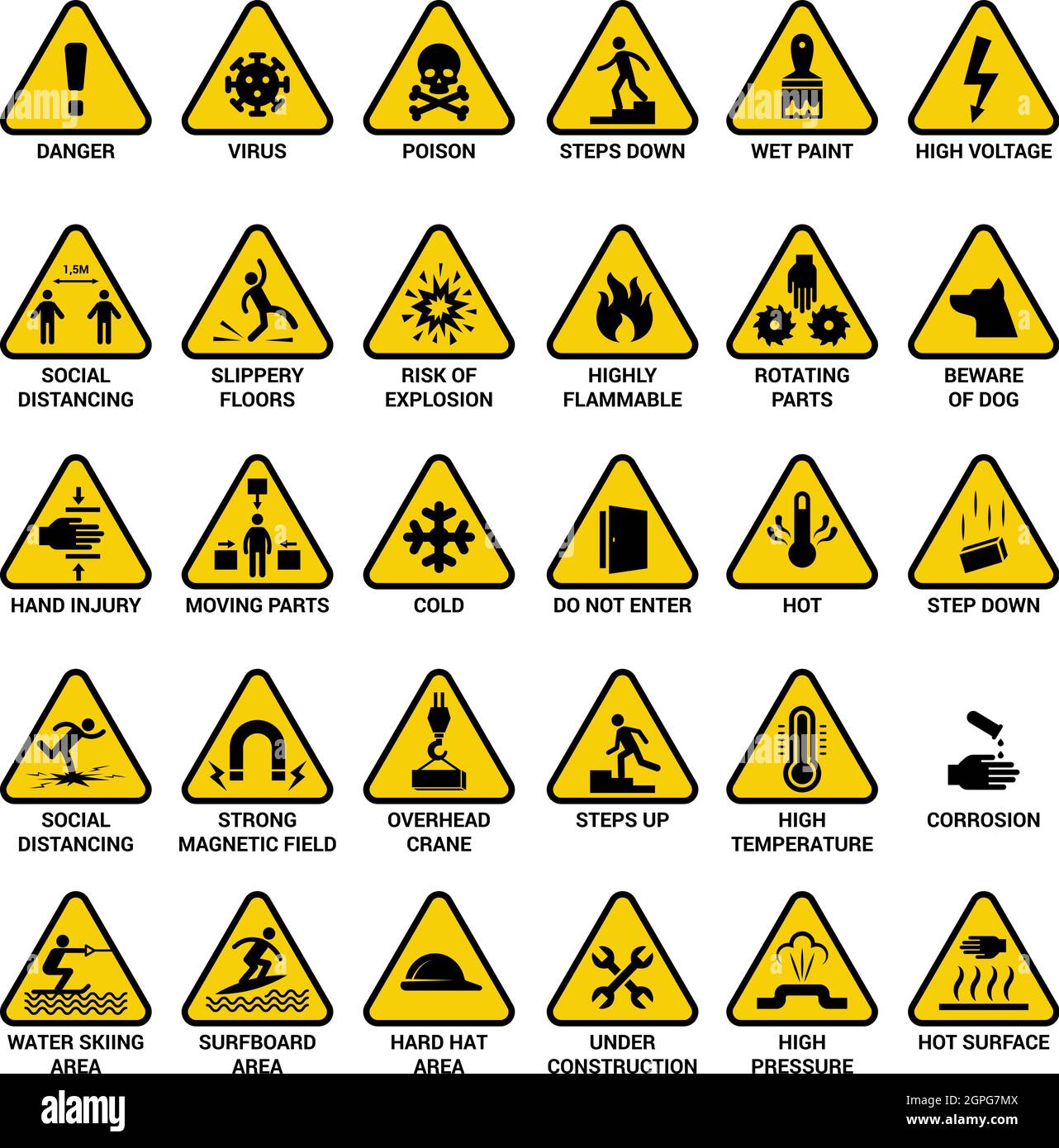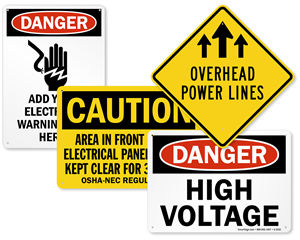Electrical safety signs warn individuals of potential electrical hazards. They ensure safety by alerting to dangers and promoting precautions.
Electrical safety signs play a crucial role in preventing accidents and injuries. These signs are typically found in workplaces, construction sites, and areas with high voltage equipment. They use universally recognized symbols and colors to convey warnings clearly. Yellow and black are common colors for caution, while red often indicates danger.
Proper use of these signs ensures that everyone is aware of the risks and can take appropriate measures to stay safe. Regularly updating and maintaining these signs is essential for ongoing safety. Employers must educate their staff on the meaning and importance of these signs to foster a safe working environment.
The Importance Of Electrical Safety Signs
Electrical safety signs are vital. They keep people safe around electrical hazards. These signs warn of potential dangers. They guide actions to prevent accidents.
Preventing Accidents In The Workplace
Workplaces can have many electrical hazards. Electrical safety signs help reduce risks. They alert workers to danger. Signs show where it’s unsafe to touch or go.
These signs are easy to understand. They use simple symbols and words. Workers see them and know to stay safe. This helps prevent shocks, burns, and fires.
Here are some common electrical safety signs:
- High Voltage: Warns of high voltage areas.
- Electric Shock Risk: Alerts to shock dangers.
- Do Not Enter: Keeps unauthorized people out.
Compliance With Safety Regulations
Regulations require workplaces to use safety signs. Electrical safety signs are part of these rules. They ensure companies follow safety laws. This keeps workers safe and avoids fines.
Here are some key regulations:
| Regulation | Requirement |
|---|---|
| OSHA | Mandatory use of safety signs. |
| NFPA | Proper labeling of electrical hazards. |
| IEC | Standardized safety symbols. |
Following these rules is essential. It shows that a company cares about safety. It also protects the company from legal issues.
Types Of Electrical Safety Signs
Electrical safety signs are critical in preventing accidents. They inform workers and visitors about potential hazards. These signs use colors and symbols to communicate important messages.
Warning Signs And Their Meanings
Warning signs alert people to potential dangers. These signs often have a yellow background with black text or symbols.
| Symbol | Meaning |
|---|---|
 |
High Voltage: Indicates high voltage areas. |
 |
Electric Shock: Warns of electric shock hazards. |
 |
Explosive Risk: Alerts to explosive materials. |
Prohibition Signs For Electrical Control
Prohibition signs indicate actions that are not allowed. These signs usually have a red circle with a diagonal line.
- No Entry: Restricts entry to hazardous areas.
- No Smoking: Prohibits smoking near electrical equipment.
- No Water: Bans water use near electrical sources.
Proper use of these signs can save lives. Always follow the instructions on these signs. Ensure they are visible and well-maintained.
Design Elements Of Effective Safety Signs
Electrical safety signs play a crucial role in preventing accidents. Their design elements ensure quick recognition and understanding. Let’s explore the key design elements that make these signs effective.
Colors And Symbols For Quick Recognition
Colors and symbols are vital for fast identification. The use of bright colors like red, yellow, and green helps in immediate recognition. Each color represents a different level of danger:
- Red: Indicates immediate danger or prohibition.
- Yellow: Signals caution or potential hazard.
- Green: Denotes safety information or instructions.
Symbols enhance understanding without needing to read text. Common symbols include:
- Lightning bolt: Indicates electrical hazard.
- Hand with a line through it: Means do not touch.
- Exclamation mark: Signifies general caution.
Text And Font Visibility
Text on safety signs must be clear and readable. The font size should be large enough to read from a distance. Use bold fonts to highlight important words.
Choose simple, sans-serif fonts for clarity. Avoid decorative fonts that may be hard to read. Ensure there is a strong contrast between text color and background color. For example:
| Text Color | Background Color | Visibility |
|---|---|---|
| Black | Yellow | High |
| White | Red | High |
| Black | White | High |
Using clear, concise text helps in quick understanding. Avoid long sentences and complex words.

Credit: www.istockphoto.com
Placement And Visibility Of Safety Signs
Electrical safety signs play a crucial role in ensuring workplace safety. Proper placement and visibility of these signs can prevent accidents. This section discusses strategic locations and ensuring unobstructed views of safety signs.
Strategic Locations For Maximum Impact
Placing safety signs in strategic locations is essential. High-traffic areas are ideal spots. Entrances and exits should have clear signage. Position signs near electrical panels and machinery. This helps in quick hazard identification.
Emergency exits need visible signs. These guide people during emergencies. Workstations with high electrical activity should have warning signs. This ensures workers are always aware of potential hazards.
Ensuring Unobstructed Views
Safety signs must have unobstructed views. Clear visibility ensures quick recognition. Avoid placing signs behind doors or furniture. Ensure signs are at eye level for easy reading.
Regularly inspect the area for any obstructions. Clean the signs to maintain readability. Use bright colors and bold text for better visibility. This helps in faster hazard identification.
| Location | Purpose |
|---|---|
| Entrances and Exits | Guide people safely |
| Electrical Panels | Highlight high-risk areas |
| Workstations | Warn workers of potential hazards |
Maintenance Of Electrical Safety Signs
Proper maintenance of electrical safety signs is crucial for workplace safety. These signs warn workers of potential hazards. Keeping them in good condition ensures everyone stays aware and safe. Regularly inspecting and updating these signs is essential.
Regular Inspections For Sign Integrity
Regular inspections help ensure the signs remain effective. Check signs for any wear and tear. Look for faded or damaged signs. Replace any that are not clear or legible.
- Check signs weekly.
- Ensure signs are clean.
- Replace damaged signs immediately.
A clean and clear sign is more likely to be noticed. Ensure the signs are placed in visible locations. This helps in maintaining a safe environment.
Updating Signs For Current Standards
Safety standards change over time. Ensure your electrical safety signs meet current standards. Outdated signs may not offer adequate protection.
- Review current safety guidelines.
- Update signs to meet new standards.
- Train staff on any changes in sign meanings.
Using the latest signs ensures compliance with safety regulations. This keeps the workplace safe and reduces liability risks.
| Task | Frequency |
|---|---|
| Inspect signs | Weekly |
| Clean signs | Monthly |
| Update to current standards | Annually |

Credit: www.compliancesigns.com
Training Employees On Sign Interpretation
Training employees to interpret electrical safety signs is vital. Proper understanding can prevent accidents and injuries. This training helps employees recognize hazards and act accordingly.
Incorporating Sign Education Into Safety Training
Include sign education in all safety training sessions. Use real-life examples to explain different signs. Create a dedicated module on electrical safety signs. Ensure employees understand the color codes and symbols. Provide handouts and visual aids for better comprehension.
| Sign Type | Meaning |
|---|---|
| Warning Signs | Indicate potential hazards. |
| Mandatory Signs | Show required actions. |
| Prohibition Signs | Specify forbidden actions. |
Interactive Learning For Better Retention
Interactive learning methods boost retention rates. Use quizzes and games to test knowledge. Implement role-playing scenarios where employees identify and respond to signs. Encourage group discussions to foster team learning. Provide feedback to help employees improve their understanding.
- Quizzes to test knowledge.
- Games for interactive learning.
- Role-playing to simulate real-life scenarios.
- Group discussions for team learning.
Training should be ongoing. Regular refreshers ensure employees stay updated. Keep the sessions engaging and informative.
Legal Requirements For Electrical Safety Signs
Electrical safety signs are vital for workplace safety. They prevent accidents and protect workers. These signs must meet specific legal requirements. Proper signage ensures everyone understands the dangers.
National And International Standards
Different countries have their own standards for safety signs. In the USA, OSHA provides guidelines. OSHA stands for Occupational Safety and Health Administration. They set rules for workplace safety.
Internationally, ISO 3864 is a key standard. ISO stands for International Organization for Standardization. This standard uses symbols and colors to communicate hazards. It makes safety signs understandable worldwide.
| Country | Standard |
|---|---|
| USA | OSHA |
| International | ISO 3864 |
Consequences Of Non-compliance
Ignoring these standards can lead to severe consequences. Companies may face legal penalties. Fines can be hefty and impact the business financially.
Non-compliance risks employee safety. Injuries can occur due to improper signage. This can lead to lawsuits and compensation claims.
- Legal Penalties: Fines and sanctions from regulatory bodies.
- Financial Impact: Increased insurance costs and compensation claims.
- Employee Safety: Higher risk of accidents and injuries.
Ensure your workplace uses proper electrical safety signs. Follow national and international standards. Protect your employees and your business.
Advancements In Safety Sign Technology
Electrical safety signs have come a long way. Modern technology has made them more efficient and effective. The advancements in safety sign technology ensure better workplace safety. Let’s dive into some of these advancements.
Digital Signs And Alerts
Digital signs are revolutionizing safety in various industries. They offer real-time updates and alerts. These signs can display dynamic messages, unlike static traditional signs. This makes them highly effective in communicating urgent information.
- Real-time updates: Digital signs can show real-time data, enhancing safety.
- Flexibility: You can change the message on digital signs quickly.
- Visibility: Digital signs are bright and easy to read.
Digital alerts can also be integrated with other safety systems. For instance, they can link with fire alarms and emergency systems. This integration ensures that everyone is informed promptly about any risks.
Smart Signs For Enhanced Safety Measures
Smart signs are the next step in safety sign technology. They use sensors and connectivity to provide advanced warnings. Smart signs can detect changes in the environment and react accordingly.
| Features | Benefits |
|---|---|
| Sensors | Detect hazards like gas leaks or high temperatures. |
| Connectivity | Connect with other devices for comprehensive safety. |
| Automatic Updates | Ensure that the information is always current. |
Smart signs can alert workers to potential dangers instantly. They can also send notifications to management for quick action. This makes them invaluable in high-risk environments.
Customizing Safety Signs For Specific Environments
Ensuring electrical safety is vital in any workspace. Customizing safety signs for specific environments makes safety measures more effective. A well-designed sign can prevent accidents and injuries. Different industries have unique requirements. Tailored signage solutions are essential for these varied needs.
Industry-specific Signage Solutions
Different industries need different safety signs. For example, construction sites have many electrical hazards. Signs must be bright and easy to read. Factories often have heavy machinery. Signs should highlight areas where electrical risks are high. Hospitals require clear signs for emergency exits and equipment rooms. Custom signs ensure everyone understands the risks.
Addressing Unique Workplace Hazards
Each workplace has unique hazards. Customize signs to address these specific dangers. For example, laboratories use various chemicals. Signs should warn about electrical equipment near flammable substances. Offices might seem safe but have hidden electrical risks. Signs can indicate safe zones and equipment locations. Custom signs provide clear instructions.
| Industry | Hazard | Signage Solution |
|---|---|---|
| Construction | High Voltage Areas | Bright, Reflective Signs |
| Factories | Heavy Machinery | Warning Signs with Icons |
| Hospitals | Emergency Exits | Clear Directional Signs |
| Laboratories | Flammable Chemicals | Warning Signs with Specific Instructions |
| Offices | Hidden Electrical Risks | Informative Signs Indicating Safe Zones |
- Bright colors and reflective materials improve visibility.
- Icons and symbols convey messages quickly.
- Clear instructions ensure everyone knows what to do.
Custom safety signs make workplaces safer. They address specific hazards and meet industry needs. Proper signage saves lives.
Case Studies: The Impact Of Safety Signs On Accident Prevention
Electrical safety signs play a critical role in accident prevention. Through real-life case studies, we can see their effectiveness. These studies highlight both successes and failures, providing invaluable lessons.
Real-life Success Stories
Many companies have implemented electrical safety signs effectively. These efforts have led to a significant reduction in accidents. Here are some success stories:
| Company | Accident Reduction | Key Safety Signs Used |
|---|---|---|
| ABC Manufacturing | 50% reduction |
|
| XYZ Electrical | 70% reduction |
|
These companies saw a dramatic drop in accidents. They used clear, well-placed signs to guide employees. Workers were better informed and could take proper precautions.
Lessons Learned From Safety Failures
Some companies learned the hard way about the importance of safety signs. These lessons are crucial for improving safety measures:
- Inadequate Signage: One company faced a 30% rise in accidents. Their safety signs were too few and poorly placed.
- Outdated Information: Another company used old signs. They did not update signs to reflect new hazards. This led to confusion and accidents.
- Employee Training: A firm ignored training on safety signs. Workers did not understand the signs’ meanings. This resulted in multiple incidents.
These failures teach us that clear, updated, and well-placed safety signs are essential. Proper training ensures that employees understand and follow these signs.
Electrical safety signs are not just a formality. They are vital for protecting lives and maintaining a safe workplace.

Credit: www.alamy.com
Frequently Asked Questions
What Are Electrical Safety Signs?
Electrical safety signs warn about electrical hazards. They help prevent accidents and ensure safety in workplaces. These signs include symbols and text to indicate danger, caution, or instructions. Proper use of these signs is essential for maintaining a safe environment.
What Are The 5 Main Safety Signs?
The 5 main safety signs are: 1. Prohibition signs (e. g. , No Smoking) 2. Warning signs (e. g. , Hazardous Material) 3. Mandatory signs (e. g. , Wear Safety Goggles) 4. Emergency signs (e. g. , First Aid Kit) 5. Fire safety signs (e.
g. , Fire Extinguisher Location)
What Are The 4 Types Of Safety Signs?
The four types of safety signs are: 1. Prohibition signs: Indicate actions not allowed. 2. Warning signs: Alert to potential hazards. 3. Mandatory signs: Specify required actions. 4. Emergency signs: Show escape routes and first aid locations.
What Are The Osha Signage Requirements?
OSHA signage requirements mandate clear, legible signs to warn of hazards. Use specific colors and symbols for safety. Signs must be visible and understandable. Compliance ensures workplace safety and avoids penalties.
Conclusion
Recognizing electrical safety signs can save lives and prevent accidents. Always stay vigilant and prioritize safety. Understanding these signs ensures a safer environment for everyone. Never ignore or underestimate their importance. Keep yourself informed and protected. Share this knowledge to promote a safer community.
Stay safe and alert at all times.




